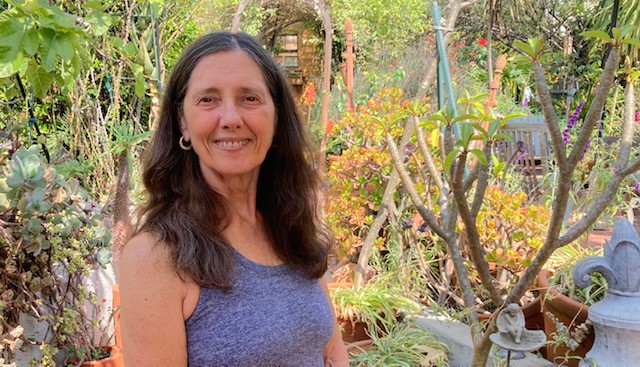Yoga has been a significant part of her journey to full health
Age may be “just a number,” as I’ve read on T-shirts lately, but metabolic age is a sign. Of fitness. When your metabolic age is 27 and it equals your chronological age when the numbers are reversed, well, then the world wants to know your secret.
World, meet Susan Angenendt.
At 72 (and metabolically 27), she paints, plays piano, climbs mountains, swims, hikes, kayaks, bikes, and teaches yoga on chairs, on mats, and in swimming pools.
Even more remarkable, however, is that for five years she had lost the use of her hands. Yoga has been a significant part of her journey to full health.
(She says she’s fitter now than she was in her 20s!)
I met Susan at the gym. At the beginning, she was only a fellow swimmer and a locker room friend, but she later became my yoga instructor. Had the club not closed the pool for half a year to remove and reconstruct the pool area, I may never have called her “my favorite yoga teacher” because I wouldn’t have tried her 6 a.m. yoga class on Tuesdays and Thursdays.
But the pool closed, Susan invited me to class, and the rest, unfortunately, is history.
“Unfortunately” only because it was a lovely history but IS history; Susan no longer teaches live classes at the gym. However, her yoga classes changed my view of the practice because she emphasized how our bodies work and why she modeled the poses she wanted us to mimic.
Her “why,” of course, was because she found yoga’s focus on balance and alignment healing and critical to her ability to function, especially as she aged.
How she lost the use of her hands
A serious amateur flutist, one Christmas Susan spent two weeks “on task” practicing her flute and typing on a typewriter. Playing lots of notes. Typing lots of notes. But between her bad form and the tension, rather than finding herself a more accomplished flutist at the end of her time on task, she found she had lost the use of her hands.
“I was using a lot of muscles, and by the end of that two weeks I lost the use of my hands. They didn’t hurt, but they had no strength,” Susan, then 45, remembered. “I couldn’t carry a dish to the table without dropping it.”

For five years, she was unable to function as she had. Playing flute was history. Typing difficult. Doctors had diagnosed carpal tunnel syndrome, but no suggested therapy seemed to help. Then a friend told her of a massage therapist who worked with musician injuries.
“I went to him, and he diagnosed the problem as thoracic outlet syndrome. It took us about a year to fix the problem,” Susan recalled. Neurogenic thoracic outlet syndrome happens when the network of nerves running between your collarbone and top rib get compressed. It causes numbness, tingling, aches, and pains in the shoulders, arms, and hands, and can cause weakening of the grip (Mayo Clinic).
How Susan found relief
The massage therapy relieved Susan’s thoracic outlet syndrome and also enabled her to work correct alignment and posture into her yoga.
“As I learned more about the body and the interrelationship of different parts and the causes of problems in the body, I got more and more interested.”
She had been a student of yoga, but what she learned about the human body and alignment inspired her to go through teacher training. She is now a certified yoga therapist.
“As I trained, I was doing more yoga, and the poor alignment I had practiced without knowing it resulted in rotator cuff issues,” she said. “Then I had some sciatic nerve issues. But I was able to work through them and learn how to deal with them.”
Her growing knowledge of the human body and how it works drives her belief that if someone in pain is willing to work – and she’s willing to work with them – they can feel better.
“There’s always a reason for the big pains you have,” Susan said. “You just have to tease it out and keep working on it to get the right answer. That’s the approach I use with the body – my body and my students’ bodies.”
Has she ever found someone who wasn’t benefitted by this?
“No, I haven’t actually. Unless they’re really here to have me ‘use my magic wand’ to fix them,” she said. “As long as they’re willing to work and I’m willing to work, everybody benefits.”
How Susan teaches yoga
What I appreciated most about Susan was how accessible she made yoga. As a Christian, I had always looked at yoga as a “religious” experience rather than a form of fitness. The instructors were always somber, the music eerie (to me), and some even burned incense. I wasn’t a fan.
Susan’s class was different. She greeted each person with a smile. She played piano music – including George Winston, my favorite, and some Christian music I recognized. She was funny, using quips such as “let out your inner Elvis” and “one day both sides of your body will behave.” She laughed at herself; we felt free to laugh at our glitches, too.
“Poses are only suggestions” was her common refrain, followed by “Do what feels right for your body today.”
“I want my students to fit the pose to their bodies rather than make their bodies fit the pose,” Susan explained as we chatted last week. “All of our bodies have different skeletal and tissue structure as well as different histories of use and injury.
“We have to honor the differences.”
Susan, a Ph.D. in educational psychology, is a professional behavior analysist, and she employs that ability in her yoga classroom.
“I always felt you were student-oriented, as if you could quickly look at a class and determine the level and ability of your students,” I told her during our conversation. “Even though you might be targeting the least experienced person in the class with the exercises that day, you still challenged the most experienced student – without overchallenging the newbie.”
How she makes yoga meaningful
Each class, Susan started with a theme – maybe the alignment of our head, maybe shoulder openers. Sometimes she brought props – wooden dowels, for instance – to help us feel (and hear, when the dowels fell and hit the floor) the alignment of our spine. Sometimes she brought books to show us postures and the muscles involved.
Her enthusiasm, her diligence in providing the goal, the why, and the how of the pose gave me a desire to do yoga well. As I struggled with lower back pain (“engage your core, Sara”), rotator cuff issues, and my own bout of thoracic outlet syndrome, Susan suggested ways to adjust my poses to aid my recovery. (Not prescriptions or dogmas, I should say, but insight into how the body works.)
Susan does the same with her personal practices, too. Because she had so many engrained “bad habits” playing flute, as she called them, she did not resume playing the wind instrument but became serious about playing piano instead.
As she nears her 73rd birthday, Susan inspires me to pursue fitness as a way of life and a way of healing what ails me through body alignment, strength training, balance, and flexibility.
And falling, actually.
How often did Susan teach us to fall with fluidity?
“Before you go out walking on our icy streets today,” she would quip, turning her gaze to the windows framing a still-dark morning that promised another toasty Florida day, “you need to know how to fall so you don’t hurt yourself.”
She would then mime what not to do: falling stiffly, arm and hand straight and in danger of breaking a bone.
“Or you can crumble to the ground safely,” which she would demonstrate.
And so we would practice melting to the ground and getting our bodies back into a standing position over and over. (Talk about weightlifting! And you thought yoga was all about breathing and sitting?)
“So I took a fall yesterday,” Susan told me. “There was a driveway that I hit just wrong and I went flying.”
She held up her hands so I could see them on my Zoom screen.
“No scrapes. No road rash, even though I hit the side of my leg too.”
No bruises. No broken bones.
“That’s why we practice falling,” she said. “Because all you have, I keep saying it, all you have time for when you start going down is a quick expletive.”
Which is what I might have wanted to utter when Susan conveyed the news that she would no longer be teaching classes at the gym. She does offer classes via Zoom – and if you’re interested in connecting with her, please reach out to me (you can email me at [email protected]), and I’ll connect you.
I‘m gathering stories from people who inspire me. When I learn that a person has struggled or struggles with an ailment of some kind and still shows up to exercise, I’m encouraged to persevere, to “buffet my body and make it my slave,” as the Apostle Paul said (1 Corinthians 9:27, NASB). I hope you’re inspired, too.
Let’s connect!
I’d love for you to share your thoughts in the comments or like this post or follow me. Or all three! You can receive my latest post via an email alert. Just enter your email address and watch for an email from Sara at All Things Work Together.


Lovely article, Sara. Susan brings a calming peace by simply talking to us.
LikeLiked by 1 person
Plus she makes me laugh — in yoga! She’s so real I feel I can be fully me and fully engaged in her class.
LikeLike
I really learned a lot reading this! Not sure I’m ready to try yoga classes! 😊. It is available in our Fitness room! As usual, well written! 💘, Blessings, Aunt Claire
LikeLiked by 1 person
I wish you could take Susan’s classes! (I wish I could, too.) Thank you!
LikeLike
Sara, this is a great post sand Susan’s story is a testimony to the healing power of yoga – and I can relate to how much you enjoy a teacher – I have different yoga teachers for different things I appreciate (if that makes sense)
LikeLiked by 1 person
Makes complete sense! They are all so different. I’ve told Susan she’s ruined me for other teachers. She’s by far my favorite. Thanks, Prior!
LikeLiked by 1 person